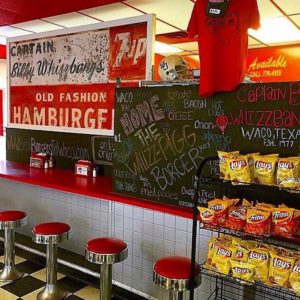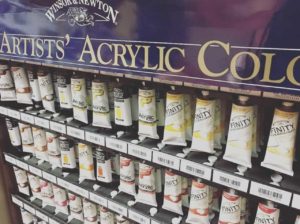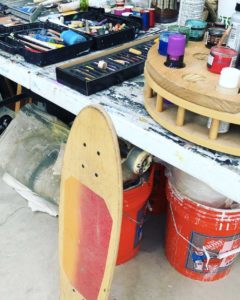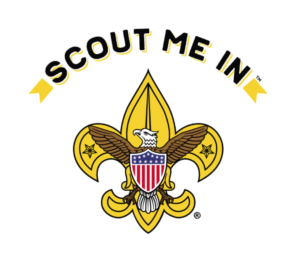(Welcome to the Act Locally Waco/Towny blog series. Towny is an app that exists to connect consumers with local businesses. It’s loaded with answers to the question, “Why local?” Through this blog series, the folks at Towny will be sharing the stories behind some of our high-quality, local products and helping you get to know some of our energetic local entrepreneurs. We hope you enjoy it! Supporting local business is a terrific way to support the Waco economy! Plus, it’s just fun to get to know your neighbors. For more posts in this blog series, click here: Towny Waco.– ALW)
by Tori Freeman
What do hot air balloons and hamburgers have in common?
Long ago, a cross-country hot air balloon trip gone astray landed one fame-seeking, adventure-chasing Captain Billy Whizzbang in central Texas. Too ashamed of his failed attempt to return home, Capt. Billy instead invented a specially prepared hamburger and opened up Captain Billy Whizzbang’s Old Fashion All American Hamburger Stand. Or so the story goes.
In today’s post, Captain Billy Whizzbang’s honors the legacy of the famed Capt. Billy by serving up the same old-fashioned style of burgers. Owner Trent Neumann shared with us some of what’s been cooking over at his restaurant…
Can you tell me about the origin of this restaurant and how you got connected with Captain Billy Whizzbang’s?

“The business started back in 1977. A guy by the name of Mike Parton started it a long time ago. It went through a couple different owners’ hands, and I bought it in July of 2009.
“The guys who owned it before me were friends of mine and they were looking to sell it. It was actually me and my dad who went in and bought it. And then about a year and a half later, I bought my dad out of it.”
What changes have you made since you took over?
“We cleaned it up a bit but we kept the same kind of tradition. Captain Billy Whizzbang’s has been around a long time, so there’s a lot of good things that were already going on. We kept with the same old-school way of doing stuff, buying everything fresh and as much local as we can.
“For example, we buy all of our meat every day from the local meat market here in town. I call first thing in the morning, like 7 o’clock every morning, and tell them how much meat we need. They deliver that fresh every day, and then we take that meat, mix in our seasonings, and then hand patty every patty.”
What makes Captain Billy Whizzbang’s stand out from other restaurants?

“That’s the main thing that makes us, in my opinion, so much better – the freshness of everything that we do and then the attention to detail that we have. Everything we make is to order. We don’t pre-cook anything. We don’t hold anything in warmers. We don’t do any of that kind of stuff. As soon as people walk in and place their order, we make it exactly how they want it and fresh every time.
“We also have something on our menu called our Whizz-Pigg hamburger, which is a half ground bacon, half ground beef patty. It’s been one of our favorites for the about last four years.
“That’s actually the burger that was featured when the TV show, The Texas Bucket List, came in and did a special on us. That was in March of 2017.

“Then a couple months later, toward the end of their season, I got another call. They feature a burger restaurant every episode, so at the end of the season they do a special on their top five burgers of the season. They picked ours as their number one, so that was really good for us.”
Do you have any other highlights or favorite parts of running the business?
“Seeing how much we’ve grown is one thing. We went from doing anywhere from 75 to 100 hamburgers a day to now we’re making around 300 to 350 hamburgers a day. It’s pretty fun to see that kind of growth.
“Also, adding our food trucks was a big deal. We have two food trucks right now. One of them is at the Silos every day. And then the other one we use for a lot of catering and to go out to special events and different festivals.”
Are there any customer interactions that stand out to you?
“I can’t think of any individual, but we definitely have a pretty loyal following here in Waco. I would say that probably 60 or 70 percent of our customers eat here at least once or twice a week. We even have one guy who comes in almost every single day to get food. So, we have a close relationship with a lot of our customers, and to see that is pretty neat.”
What do you love most about the Waco community?
“Oh, Waco is just awesome. I mean the local people are great. They tend to really support local businesses. As many other restaurants – and especially bigger chain hamburger restaurants – as have come into our area, we have never seen it affect our business at all.
“If anything, we’ve grown at a steady pace. That alone shows that the local community really supports us, and they really support local businesses in general, which is pretty awesome. Anything that we can do to give back and to help support Waco, we try to do.”
Well, Waco, you’ve earned yourself a shout out for supporting local! Keep up the good work with the help of Towny – your free online guide to shopping local. (PS – Want it on the go? There’s an app for that!)

Tori Freeman is a Colorado native turned Texan and a graduate of Baylor University. She works as a part-time paralegal and creative freelancer with expertise spanning writing, editing, and photography. Tori knows firsthand how local businesses can change lives—she met her husband, Braden, while working at the Hippodrome! They now happily live in Waco with their spoiled golden-doodle and their even more spoiled baby boy.
The Act Locally Waco blog publishes posts with a connection to these aspirations for Waco. If you are interested in writing for the Act Locally Waco Blog, please email [email protected] for more information.
By Jessica Attas
As we wrap up the year and look to the year ahead, the Texas 86th Legislative Session looms large on the horizon and front of mind.
As the organization dedicated to the economic well-being of the area, we at the Chamber seek to actively promote policies that are conducive to growing a thriving economy and community. Our ability to help develop the economy- and your ability to help your business flourish- is impacted by state and federal policies and the regulatory environment in which we operate. For that reason, your Chamber of Commerce is active in the public policy sphere, advocating for businesses to our legislators on issues of importance to our community.
Prior to every state legislative session, we go through a process to seek input from our members on their policy priorities, and with our public policy committee together with other community stakeholders, listening to the conversations being held around the state about coming policy debates, develop a relevant legislative platform to inform and guide our advocacy work in the session and the interim that follows.
The past few months have held a great deal of conversations at the state and local levels related to property tax, school finance and workforce development. Indeed, the growth of property tax and the quality and future of our workforce are both directly related to school funding, and are in fact consistently the top concerns we hear from business members.
The manner in which schools are currently funded is too heavily reliant on local property tax dollars. As economic growth occurs and values rise, the state uses the increased local contributions to themselves pay less in per-pupil spending. The state’s budget plans on (and some might say mandates) that, and calls for increased property tax valuations ranging from 6-7% annually for each of the next two years. This allows the state to pay less, by shifting the cost down to local taxpayers. Where the state used to pay for the majority of per-pupil costs to educate our children, it has now fallen to 37% of the cost being paid by the state and the balance by local property tax payers. Without reform to the way we fund our schools, that will drop to just 30% by 2023. At a time when Texas already has the 46th highest property tax burden of all fifty states, this will inevitably mean millions more dollars that will have to be collected locally in order to offset the loss of state dollars. Every property owner can expect their local property tax bill to increase if no changes to the way we fund our schools are made.
The question of how we fund our schools also ties in with whether they are adequately funded. While money isn’t the only determining factor, it is a factor. Money matters in education, and money well-spent can allow our schools to produce the student outcomes we need. Recognizing our currents skills gap and that our student outcomes are not aligned with what our businesses need, Governor Abbott called on three key agencies- the Texas Workforce Commission, Texas Higher Ed Coordinating Board, and the Texas Education Agency- to work together on a shared vision for the workforce our state will need if we are to keep our economic strength. That vision is called 60x30Texas, and aims to see 60% of Texans aged 25-34 hold post-secondary degrees or higher by the year 2030. This is a data-driven goal; by just 2020, more than 60% of jobs created will require some sort of post-secondary degree. The current reality provides a stark contrast. At present, just over 30% of graduating students in Texas test on the ACT or other college or career readiness measures as “college-ready,” and less than 30% of high school graduates have completed any post-secondary degree six years after graduating. The implications for our future workforce- and our ability to sustain and grow our economy- if we do not act, are grave.
For these reasons, key priorities as we move into the legislative session are addressing property tax reform; opposing increases in local appraisal growth mandated by state budget planning; and increasing the state’s share of per pupil spending on public education, focusing those dollars on the strategies proven to improve student outcomes in order to build a 21st century workforce. Further, the process of appraisal valuation needs reform, and we call on improvements to include local input on valuation ranges. At present, the state sets target valuation ranges based on a sample of properties, and each appraisal district has to come near that target. Aligned with our overarching support of local control, a priority is local input on those target ranges.
Because there has been significant conversation at the state level around these interwoven issues of property tax and school finance, they are key priorities for our Chamber. However, as the organization responsible for the economic development of the area, we also have state legislative priorities regarding competitive incentives, small business and entrepreneurship, and trade and international competitiveness. We continue to support the Texas Enterprise Fund- the state’s deal-closing incentive fund- and call on the legislature to expand accessibility to the fund for existing businesses of all sizes throughout the state.
Of course, your Chamber of Commerce is a membership-driven chamber, and there are issues across the board that impact your ability to develop and grow your business. As an example, given this issue is focused on healthcare, we know access to a healthy workforce impacts day-to-day business operations. However, access to healthcare in Texas is limited, and in fact, Texas has a rate of uninsured more than twice the national average (26% compared to 11%). Further, Texas is also experiencing both a physician and a nursing shortage. Half of Texas counties do not have sufficient physicians for their population and thirty-five counties have not a single physician. For that reason, legislative priorities focused on healthcare include things like expanding access to healthcare coverage; prioritizing preventative and behavioral healthcare; supporting robust nursing programs and allowing those nurses to practice within the scope of their expertise; and given that doctors are most likely to work where they do their residency, prioritizing additional medical residency slot funding over new medical school funding.
Our legislative agenda is robust yet focused, prioritizing those topics of greatest impact to our businesses: business climate (including fiscal policy and regulatory reform); economic development; public and higher education; healthcare; transportation and infrastructure; and water and natural resources. To see our full state legislative agenda for the 86th session, please visit our website or reach out via email to [email protected]. If you become aware of a bill during session that would impact your business or your industry, please let us know. It is our charge to be the voice for the business community of Waco in Austin; we look forward to working and standing with you for the good of our community in the months of legislative action ahead.

Jessica Attas is the vice-president of public policy for the Greater Waco Chamber of Commerce. She works with key state and federal elected and appointed officials to advocate on key issues of community and economic development. Attas loves thinking about solutions for big challenges, and when her schedule allows, enjoys serving as a professor in the Baylor Interdisciplinary Core Honors College. Attas has two sons and a pup who keep her busy during “down time.”
(Welcome to the Act Locally Waco/Towny blog series. Towny is an app that exists to connect consumers with local businesses. It’s loaded with answers to the question, “Why local?” Through this blog series, the folks at Towny will be sharing the stories behind some of our high-quality, local products and helping you get to know some of our energetic local entrepreneurs. We hope you enjoy it! Supporting local business is a terrific way to support the Waco economy! Plus, it’s just fun to get to know your neighbors. For more posts in this blog series, click here: Towny Waco.– ALW)
by Marissa Minter
MC Art Supplies, located at 2025 Washington Ave. in Uptown Waco, is well known as a haven for local artists. Shop Owners Aaron and Jessica Williams have created a warm environment where all artists – from the novice to the expert – can feel comfortable and find almost anything they need. We spoke with Aaron to learn more about what makes MC Art Supplies the wonderful shop artists know and love in Waco.
How did you get into this business?

“My sister, Mackenzie, was an art student at Baylor, and she would come to MC Art Supplies to get all of her art supplies. She became close friends with the original owners, Rose and Clyde. She learned that they were going to close down the store and retire. Around the same time, my wife and I were looking for something new to get into. We wanted to start working for ourselves, and we also were excited to contribute to all that’s going on in Waco. There’s so much going on in the downtown area, and we’re right in the middle of it. We’re super fortunate to be a part of it. Anyways, long story short, we wanted to keep this place going so we took over.
Clyde just turned 91 this year, so he had definitely earned retirement. Both he and Rose were really sweet and great when helping us take over. When my wife and I finally met them it was like we had known each other for a long time. I never thought I would take over a retail store like this, but we had a lot of help along the way from people who had done this before. Rose and Clyde were very happy that we decided to continue their store.”
How has your experience as a store-owner been?

“It’s been almost two years. We’ve survived three back-to-schools already so we’re getting the hang of it. At the beginning it was chaotic and crazy but we’re getting the feel for it. When we first took over the store, our biggest customers were students at Baylor and McLennan Community College. Of course, we expected to have customers through those art programs, but we were also pleasantly surprised by how many artists live in Waco. There are people moving from places like Austin and out-of-state, and they’re bringing their flavor and creativity to Waco. It’s neat to meet the people who come through our doors. I learn new things every single day. Every time I think I’ve figured it all out, there’s some new item that someone will come in and ask about. And I’ll say, ‘let me try to make that happen for you.’”
That’s awesome! Do you prioritize ordering new products for your customers?
“Well, we’ve had the opportunity to meet other small business owners and ask how they set themselves apart. One of the things I’ve learned from them is that you should create an atmosphere people want to come to. That goes hand-in-hand with doing what we can to get people the items they need or want. I’m going to make every effort to get something in our store or special order it if it’s something I know we can get from one of our vendors. We really want to be advocates for our artists.”
How are you and your wife as a team?

“My wife works full-time in another job, so I’m pretty much here all the time. She’ll tell you that I’m definitely an extrovert. I’m not afraid to have a conversation with people, and it’s where I excel. My wife is the one who keeps it all together. She’s the brains behind the operation for sure. We’re kind of the perfect team. She’s incredibly creative, too.” My wife and I have characteristics that drive each other crazy sometimes, like every couple. But we always find middle ground. We’ve always been a really great team from the get go.”
What is your experience as an artist?
“I’ve always been right-brained. I’m not a painter, but I am a musician – I’ve always been an artistic person and appreciated art. I love seeing what an artist will create with the stuff we sell. Sometimes customers will come back with the art they’ve made after shopping here, and it’s just incredible and brings me tons of joy.”
Do you have any funny stories from your time running MC Art Supply?
“We’ve been doing a lot of renovations here in the store. If you’ve ever been to Poppa Rollo’s restaurant here in Waco, you’ll know there’s a door that doesn’t look like a door. We discover unique things like that here at the store all the time. Every time we think we’ve cleaned everything up, we’ll get to another part of the store that’s just full of surprises. Some of it has been awesome. For example, we’ll find a ton of paintings from Clyde that are amazing. Then sometimes, we’ll find inventory that’s super old and not really needed. We’ve put those items on a sale table in the store.”
What are some of the dreams you have for MC Art Supply?

“Our biggest thing right now is that we’re trying to add as much inventory as possible. We’re doing that because we want to set ourselves apart from the bigger box stores that might not have as much variety. We try to find things that will get artists excited. I want the store to get to the point where people can walk in here and find anything they need.
Another thing we’ve done recently is added a studio room. There was a room where most of the merchandise used to be, but now it’s a studio where we can host paint nights, classes, and meet ups. Community involvement is our biggest goal for next year. Starting January and February is when we’ll launch that. We’ve got a list of people who said they’d be willing to teach these classes, and several other art groups around Waco are interested in using different spaces like ours.”
Last question: what do you love about Waco?
“I was born and raised here. There has always been a sense of genuine community. Waco as a whole is a very welcoming city. The people here aren’t stuck up or fake. It’s really the people that make me love Waco – that and Cameron Park!”
When you shop at local Waco businesses like MC Art Supplies, you are not only building a robust economy, but you are also supporting your very own neighbors. Find them on Towny – the free tool making it easy to choose local.

Marissa Minter is a writer and creative from Houston, Texas. Since graduating from Baylor University in 2014, Marissa has traveled, explored, and learned a lot about life and people. Marissa is passionate about Towny because she loves the idea of encouraging people in Waco to care about and support local businesses that make Waco the wonderful place it is!
By Ashley Bean Thornton
I’m a big believer in New Year’s Resolutions. I come up with one or two every year and probably every other year or so, I stick with one. Sometimes they are quite dramatic. One year I decided to make walking my default form of transportation; that was life-changing. Most years they are small and concrete, e.g. floss every night. Some years they are personal – spend one hour a week on cleaning the house. (Don’t judge!) Some years they have more of a community focus – pick up a bag of trash once a week.
My resolutions aren’t earth shattering, but they help me remember that even a little effort applied consistently toward a goal can make a difference, and having a goal makes it more likely I will make the effort. The smallest thing I actually do has more impact than the biggest dream with no action behind it.
Here’s a handful of ideas for resolutions with an “Act Locally Waco” twist. Maybe one of these will spark your imagination and inspire you to make a resolution or two of your own. Whether it inspires action, or a yawn and a nap, I hope you have a terrific 2019! Happy New Year! – ABT
Read one article from the newspaper every day (or once a week, or whatever…) – We are lucky to have devoted and talented journalists at the Waco Trib who keep us up to date and informed about local issues. At least once a week, and often many times more than that, I am impressed with well-written coverage of issues I care about or a thought provoking editorial (whether I agree with it or not). The first step to getting involved is getting informed.
Walk in your neighborhood once a week. – I have heard it said that air conditioning and TV killed neighborhoods. Since those two things were invented, people stay locked up in their homes when we used to sit on the front porch and visit with each other. I’m not willing to give up air conditioning and TV, but I’ll confess I don’t know my neighbors very well…and that is bad. Every speck of research I have ever read on this subject says that when neighbors are strangers, the community suffers. Crime increases, people are not as happy, we have less empathy and care for one another. I am a little bit too much of an introvert to be the one who organizes block parties and neighborhood socials, but I have found that by walking in the neighborhood regularly, I strike up casual conversations and have at least a waving acquaintance with more of my neighbors and that is – literally – a step in the right direction.
Pick up one bag of trash a week. – One year I combined my neighborhood walks with picking up a bag of trash a week. I’ll admit it was a little depressing to see how quickly I could fill up a bag of trash in my own neighborhood, but I loved the feeling of concrete accomplishment as I dropped the full bag into my gray bin with a satisfying “thunk.” This is a great resolution for a family to do together. I even know some folks who combine litter picking with jogging. If your neighborhood is not trashy enough, “adopt” a local park or another spot in town where you have noticed litter collecting. Check out the Group W Bench Litter Patrol or Keep Waco Beautiful for opportunities to participate in community clean-ups.
Find a regular volunteer gig. – A couple of places in town that do terrific work and ALWAYS need volunteers are Meals & Wheels (Contact Rachel Salazar at [email protected] ) and Caritas (Contact Andrew Bryngelson at [email protected]). The United Way is also working on setting up a long-needed volunteer portal (https://unitedwaywaco.galaxydigital.com/ ) to make it easier for all of us to find a place to plug in.
Give consistently, even if it’s just a little. – The other day I heard someone say dismissively, “Well, some people think they can just write a check, when really what they should do is get out and get involved.” I am a big proponent of getting out and getting involved, but I also want to emphasize that giving is a BIG deal. Our local non-profits depend on giving from individuals. Money they get from grants or the government often comes with many, many strings attached. That is all fine and good, but our local non-profits need money to pay the light bill and fix the washing machine when it breaks. Most grants don’t pay for those kind of every day operational expenses. We may not all have millions or thousands to give, but if a whole bunch of us would get in the habit of giving ten or twenty bucks a month to support our local organizations, it would make a huge difference in our community. Click here for a list of local non-profits who have appeared in The WHOLE Enchilada in the last year, with handy links to their donation pages. Pick one and sign up to give a little each month. By this time next year, your small gifts each month can add up to a nice sum. You might even pay the electricity bill for one month!
Do something regularly and intentionally to support Waco ISD. – I could write a whole column about how our school district is the heart of our community, and how our kids are our most important natural resource, and how we will not be able to maintain our current Magnolia- fueled “sugar rush” of economic development unless we educate our work force etc. etc. and all those things are incredibly important. But, I will confess that the main reason I try to keep connected to Waco ISD is because it’s fun. Even though there are some serious challenges — maybe because there are serious challenges — it makes me proud and happy to be a part of it. “Support” can range anywhere from volunteering regularly in the lunchtime reading club program being organized by local churches (Contact [email protected] to volunteer), to making the effort to attend the annual (AMAZING!) high school musicals or other fine arts events, to talking to your employer about becoming an adopt-a-school partner.
Do something downtown once a month/Be a local tourist once a month/shop local. – People are coming from all over the world to visit Waco and sometimes those of us who live here are the ones who don’t take advantage of all our town has to offer. The Waco Convention and Visitor’s Bureau maintains a terrific events calendar and their app is easy to use and even offers coupons! (There’s no rule that says people from Waco can’t use the coupons!) The DowntownWacoTX website and Facebook page are always full of great information about enjoying downtown and The First Friday Facebook page is another good downtown resource. Follow Cultivate 7Twelve to keep up with art happenings downtown. The Towny app can help you identify local businesses and they also offer deals and coupons. Make it a goal to shop local as much as possible, to regularly attend First Friday, or to enjoy one Waco “attraction” a month. Why should the visitors be having all the fun?

This Act Locally Waco blog post is by Ashley Bean Thornton, she has lived in Waco almost 20 years now. Far longer than she ever lived anywhere else. She likes to walk. If you see her out walking, honk and wave and say, “Hi!”
The Act Locally Waco blog publishes posts with a connection to these aspirations for Waco. If you are interested in writing for the Act Locally Waco Blog, please email [email protected] for more information.
by Melody Terrell
Growth, change, and choices are on the horizon for the Boy Scouts of America, and for some Waco-area girls and their families. We hear about The BSA in national news sometimes, but the quality and fit of our programs comes down to a more personal level. Local churches and civic groups, who sponsor the troops, and the men and women who lead them have the most influence over these youth organizations. Scout leaders in Waco choose where they will serve. Families have choices about their time and interests and the youth who join organizations get to choose the right fit for them. Those who join BSA troops will have many choices within the scouting program. I’m excited about the opportunity to serve as one of the adult leaders of Family Scouts BSA Troop 308 for Girls that officially launches in February of 2019.
 The best things about Boy Scouts are not going away. The aims and methods remain the same. The requirements for the prestigious Eagle Scout award remain rigorous, identical for male and female youth. The values, camping, and opportunity for boys-to-be-boys remains. Girls will not be invading guy territory and feminizing it; they will form new all-female groups. The values I love about scouting remain: duty to God and country, outdoor adventure, youth-led with adult support. I want that for girls too. A safe environment to plan, try, fail, and figure it out is probably the best reason to join a BSA scouting group. Families looking at BSA for their daughters are generally aware of the BSA experiences. Some girls have been participating informally for years.
The best things about Boy Scouts are not going away. The aims and methods remain the same. The requirements for the prestigious Eagle Scout award remain rigorous, identical for male and female youth. The values, camping, and opportunity for boys-to-be-boys remains. Girls will not be invading guy territory and feminizing it; they will form new all-female groups. The values I love about scouting remain: duty to God and country, outdoor adventure, youth-led with adult support. I want that for girls too. A safe environment to plan, try, fail, and figure it out is probably the best reason to join a BSA scouting group. Families looking at BSA for their daughters are generally aware of the BSA experiences. Some girls have been participating informally for years.
Local churches and civic groups sponsor all BSA troops, and they select leaders according to their standards and values. These organizations also decide if they will sponsor a separate troop for girls. Locally, several Boy Scout troops explored the idea. The First United Methodist Church of Waco decided to take the plunge and sponsor a Scouts BSA girl troop. They already sponsor Boy Scout Troop 308, and Cub Scout Pack 308, which welcomed girls in September of 2018. When a group of parents approached First Methodist, the church leaders asked a few questions, then agreed. Boy Scout Troop 308 is a large troop with consistent leadership and plenty of trained adult support. For family convenience, all groups will meet on Tuesday evenings in different parts of the church. The committee includes families with a history of scouting and a few who are new to BSA scouting. We have been meeting monthly since August.
Adult volunteers, after appropriate training, get to choose how they will serve. Every adult must take the BSA Youth Protection training before they may join. There are extensive trainings provided online and in person to adult leaders serving youth. Every scout deserves a trained leader. Adults who enjoy the outdoors may join as assistant scoutmasters and help with campouts and scouting skills. Those who yearn for high adventure, may organize a trip for older youth to Philmont Scout Ranch in New Mexico, Northern Tier Canoe Base at the U.S./Canadian Boundary Waters, or Florida Sea Base. Others may plan a regional summer camp experience. They may serve on the troop committee, supporting the unit and its leadership. Adults who have a special skill may serve as merit badge counselors. All BSA merit badges give youth an opportunity to learn about a career, life skill, or hobby.
Families make choices for their time and values. There is only so much time in our daily lives. Some families seem to manage youth activities several times a week. It’s tricky when you have both mom and dad sharing this task, but for the single parent or grandparent it can be too much. Having all the children at one place for an hour each week might be helpful. I’m thinking coffee with adult conversation or a quick Target run. If BSA is not the right fit for your family, there are other organizations. There are groups for learning about agriculture, organizations specifically for empowering girls, sports teams, and church youth groups. These organizations enable youth to develop their potential for leadership, make friends, and have fun. Adult volunteers are the backbone of community groups. Consider not only enrolling your child, but volunteering. The community of volunteers serving beside you will enrich your life as well your child’s.
Youth have many choices. Learning to make choices is an important part of growing up. I hope all youth join an organization that appeals to them. BSA scouts meet once or twice per year for long-range planning in this youth-led organization. An adult committee has to approve or recommend changes to the plan based on safety and other considerations. At weekly meetings the youth make choices about merit badge study and service projects. Before campouts, small patrol groups plan their meals. One person is chosen as grub-master and must purchase the food, divide the cost, and collect from individuals. If the meal is not great, there is always peanut butter and jelly, and an opportunity to tweak the recipe and try again the next month. The girls will choose what they want to learn and do. There are currently 135 merit badges. 12 specific badges are required to earn the Eagle Scout rank, but the others are elective. Within each merit badge, there are additional choices. There are summer camps nearby and far away. There are gatherings of thousands of scouts or small backpacking trips. There are even opportunities to travel to other countries and meet scouts from all over the world. There is a world of opportunity for adventure.
I am grateful that BSA scouting is still a choice for me. I continued in scouting after my son earned his Eagle rank and started college. Now, I get to work with girls as we form this new group. Our troop won’t look like the boys’ troops. It will be a girl troop, for sure. I can’t wait to see where this adventure will take us. #scoutmein
Scouts BSA Program Information: https://www.scouting.org/scoutsbsa/
Find out more information about the Waco-area Scouts BSA Troop for girls that is forming!
- Website: www.bsawacogirltroop.org
- Email: [email protected]
- FaceBook: @ScoutsBSAWacoGirlTroop
- Instagram: @wacogirltroopsbsa
Rally Day for Families and Girls to learn about our troop: 1/22/19
4901 Cobbs Dr. Waco, TX 76710 (First United Methodist Church of Waco)
7:00 PM
 Melody Terrell is Licensed Dyslexia Therapist and retired public school teacher. She enjoys outdoor adventures with family and friends. She volunteered at The Boy Scout National Jamborees in 2013 and 2017 and serves on the Waco-Area BSA District Committee. She will staff the World Jamboree in July of 2019 and will be the scoutmaster for Family Scout Troop 308 for Girls. She was a Girl Scout and a BSA Explorer Scout in her youth, and has been a leader for Girl Scouts, Boy Scouts, and Campfire USA programs.
Melody Terrell is Licensed Dyslexia Therapist and retired public school teacher. She enjoys outdoor adventures with family and friends. She volunteered at The Boy Scout National Jamborees in 2013 and 2017 and serves on the Waco-Area BSA District Committee. She will staff the World Jamboree in July of 2019 and will be the scoutmaster for Family Scout Troop 308 for Girls. She was a Girl Scout and a BSA Explorer Scout in her youth, and has been a leader for Girl Scouts, Boy Scouts, and Campfire USA programs.
The Act Locally Waco blog publishes posts with a connection to these aspirations for Waco. If you are interested in writing for the Act Locally Waco Blog, please email [email protected] for more information.
The enrollment window is now open for Lake Air Montessori Magnet School and Hillcrest Professional Development School. Both campuses use a random lottery system for enrollment instead of specific attendance boundaries.
To enter the lottery, parents and guardians complete the application form found online at wacoisd.org/magnetapp. A separate application is required for each campus for each prospective student, and the deadline to apply is 5 p.m. on Jan. 25.
“From outstanding neighborhood schools to exceptional magnet programs, we are committed to creating a Waco ISD where every child receives a world-class education,” Dr. A. Marcus Nelson, superintendent, said. “Not every child learns in the same way. That’s why enhancing special programs is one of the bold changes fueling the transformation underway in Waco ISD. It’s also why we have great magnet schools like Lake Air and Hillcrest. We encourage parents to take a look at these campuses and see if one of them is the right choice for their child.”
Lake Air is one of the largest public Montessori schools in the nation serving students from pre-kindergarten through eighth grade. To enroll in pre-kindergarten at Lake Air, a child must be 3 years old by Sept. 1, 2019.
The Montessori model groups students in multiage classrooms. At Lake Air, 3 and 4-year-old pre-kindergarteners learn with kindergarteners. First through third graders are in the same classroom as are fourth through sixth graders and seventh through eighth graders.
Lake Air merges the Montessori philosophy, which emphasizes development of the whole child, with public education curriculum standards. Among the school’s many unique enrichment experiences, students of all ages have extensive opportunities for hands-on learning in environmental science.
“The students and staff at Lake Air believe in lifelong learning, respect, independence, global citizenship and community,” Lake Air Principal Stephanie Tankersley said. “These values are at the core of everything that we do from building fundamental literacy skills to cultivating global citizens through our middle school trip to the United Nations.”
Hillcrest is a professional development school serving students from pre-kindergarten through fifth grade. To enroll in pre-kindergarten at Hillcrest, a child must be 4 years old by Sept. 1, 2019.
Professional development schools are innovative partnerships between universities and school districts to further the professional preparation of teacher candidates and enhance student learning. At Hillcrest, Baylor students work alongside mentor teachers and clinical instructors in the classroom to hone their craft. Last year, the partnership between Waco ISD and Baylor University was recognized with the Exemplary Professional Development School Achievement Award from the National Association for Professional Development Schools.
In Hillcrest’s annual Showtime Company productions, students have the opportunity to bring learning to life through performances that they develop from concept to curtain call. The productions are one example of the school’s commitment to “everywhere learning.” Others have included an overnight experience at Cameron Park Zoo, a stay on the USS Lexington in Corpus Christi, and a tour of Little Rock Central High School to study integration.
“I love school, and I want my students to love it too,” Hillcrest Principal Amy Mathews-Perez said. “With a focus on fine arts and experiential learning, Hillcrest is a place where students can discover their passions, hone their talents and embark on a journey as lifelong learners.”
Both schools offer evening showcases for prospective students and their families. The events are an opportunity to tour the campuses and visit with administrators and teachers. Lake Air will open its doors to prospective families at 5:30 p.m. on Jan. 15, and Hillcrest will hold its showcase at 5:30 p.m. on Jan. 17.
Tours of each campus are also available by appointment. Spaces and times are limited. To request a tour, prospective families should call Lake Air at 254-772-1910 or Hillcrest at 254-772-4286. To learn more about enrolling, click here: Waco ISD Magnet School Enrollment.
 This information was provided by Waco Independent School District.
This information was provided by Waco Independent School District.
by Ashley Bean Thornton
One of my favorite things to do in the world is edit the Act Locally Waco blog.
December is a wonderful, but hectic, month for most of us so I thought it might be nice to give my beautiful bloggers a month to focus on family, friends and the joys of the holidays rather than on meeting our blog deadlines. So, for the month of December we will have one or two new posts, but mainly we will be reprising “2018’s greatest hits.”
I couldn’t possibly pick my favorites – so I used the simple (cop out?) approach of pulling up the 10 blog posts that got the most “opens” according to our Google Analytics. It is an intriguing collection that gives at least a little insight into the interests and concerns of Act Locally Waco readers.
I hope this list inspires you to go back and re-read your personal favorites. There have been so many terrific ones… but of course they couldn’t all be in the list of the 10 most opened. I would love for you to reply in the comments or on the Facebook page with a note about some of your favorites.
We will be reposting these in the next few weeks between now and the new year — but I know some of you are “list” people who would like to see them all at once. So, I offer the list below, with thanks to everyone who has written for the blog this year, with pride in what we have created together, and with no small amount of wonder at the beautiful complexity that makes up our beloved community! Enjoy!
Think of it as a Christmas present from your community to you, and invitation for you to write in 2019! – ABT
- I admit it…I did not want to go to the March for our Lives by Ashley Bean Thornton (676)
- Downtown Dwellers: Waco Cha Launch by Jaja Chen (561)
- What is “Co-working space?” and Why does Waco need it? By Caroline Thornton (415)
- Ascension Medical Mission at Home, brought to you by Providence by Paige Reinke (394)
- “What Were You Wearing, Waco?” by Berkeley Anderson and Geneece Goertzen (348)
- Human Trafficking: 5 Things You Need to Know by Kim Millington (323)
- What’s a Community Health Worker? By Christy Perkins (323)
- Jacob deCordova: Founding Father of Waco by Monica Shannon (312)
- Faith in Action Initiatives provides medical supplies & equipment for non-profits By Matthew Hoffman (311)
- Want to have a great time in Waco? There’s an app for that! By Karen Rios (287)
By Matthew Polk
2018 has given us lessons in the challenges and opportunities that come from working together to improve the lives of people in our community. The most obvious of these was the threat to five chronically underperforming Waco ISD campuses by a state law that requires such schools to be closed. One of the few options for Waco ISD Superintendent Dr. Marcus Nelson was to partner with a community organization to create an in-district charter school zone to provide additional support for these schools.
Through Dr. Nelson’s dynamic leadership, Waco ISD navigated this challenge first by partnering with the Prosper Waco initiative and then creating a new entity—Transformation Waco—to carry the work of school transformation forward. Before the school year started in August, Texas Education Agency announced that improved performance under Dr. Nelson had lifted the threat of closure from four of the five schools. Still, all five campuses are now overseen by Transformation Waco under the leadership of Dr. Robin McDurham.
This has created an opportunity for the community to rally around children and families in our highest need schools to provide resources and support. Students have received free eyeglasses, new early childhood and parent education programs have been launched, every WISD second grader received a personalized book to promote reading skills, and more than 840 volunteers from 41 churches are mentoring 1,650 Waco ISD students through book clubs and similar programs. From crisis has come a truly transformational community effort to provide opportunity and support for our youngest community members.
Mental health is also a crisis for many communities because of inadequate funding resulting in too few services. Our community is actively working to address this challenge. Under the leadership of the County and City, the McLennan County Behavioral Health Leadership Team is expanding the mental health resources available in our community and creating a more effective system for providing care. 2018 saw additional mental health services added at McLennan County jail and the development of court programs to divert individuals toward treatment instead of jail. School-based mental health services expanded in numerous school districts, and grant funds were awarded to Family Health Center and Heart of Texas Region MHMR to provide maternal mental health services and expand mental health support in primary care.
Among the collaborative efforts to improve the financial security of people in our community is the Bank On Waco Coalition, a collaborative group of local and national banks who have partnered to offer low- or no-cost bank accounts to folks who aren’t currently able to access banking services. The Bank On Waco Coalition also works to align its financial literacy and community outreach efforts. If you know someone who needs the security of a bank account, send them to the Bank On Waco website. Organizations can partner with the Bank On Waco members to provide financial literacy to members or clients. The Heart of Texas Community Loan Center is continuing to expand its capacity to offer low-cost loans to folks who want to avoid the cycle of payday or title loans. The Waco Employer Resource Network (WERN) continues to expand its base of employer partners and the number of employees they are connecting with local resources and services so that hardworking people in our community are able to hold down their job while tackling the bumps in life’s road. At last count, the WERN Success Coach had worked with 220 employees of partner businesses and provided more than 750 support services and referrals.
These are only a few of the ways in which our community is locking arms to improve the lives of people in Waco and McLennan County. There are many organizations and individuals playing their part in a coordinated effort to improve the education, health, and financial security of our community. Look for the 2018 Prosper Waco Initiative Report to be released in January for more information about where we stand, what we’re doing, and where we’re going as a community. And mark your calendars for the Prosper Waco Summit on March 7 to celebrate the work of the many community partners who are helping to make Waco better in 2019 than ever before.
 This Act Locally Waco Blog post was written by Matthew Polk. Matthew is Executive Director of Prosper Waco. Prior to that, he served as Superintendent of Rapoport Academy Public School. He and his wife attended Baylor, and after spending a few years in the northeast, they returned to Waco to raise their family. They have four children, ages 10 to 2 years old. You can contact him at [email protected].
This Act Locally Waco Blog post was written by Matthew Polk. Matthew is Executive Director of Prosper Waco. Prior to that, he served as Superintendent of Rapoport Academy Public School. He and his wife attended Baylor, and after spending a few years in the northeast, they returned to Waco to raise their family. They have four children, ages 10 to 2 years old. You can contact him at [email protected].
The Act Locally Waco blog publishes posts with a connection to these aspirations for Waco. If you are interested in writing for the Act Locally Waco Blog, please email [email protected] for more information.
(As I’m sure most of you probably know, one of our Prosper Waco community goals is “McLennan County residents will live healthier lifestyles and access the best available care.” With that in mind Act Locally Waco is teaming up with Better Living for Texans to bring you a monthly blog post full of tips for healthy living. For more of the posts in this series, click here: Better Living for Texans. – ALW)
by Lindsey Breunig
 Traditionally the November and December months are packed with celebrations and fun, with food at the center every time. We enjoy the holidays but quickly regret the after-effects when looking at our post-holiday waistlines. From the special meals, tasty treats, and delicious desserts, it’s easy to take in extra calories during the holidays. A small snack here and another there, combined with a large dinner and dessert, can add up to a few extra pounds. Not to mention the office party, friend gathering, or cookie decorating that come up! Fortunately, there are things we can do to discipline ourselves during the holidays. Below is a checklist to prevent overeating while having a wonderful holiday season:
Traditionally the November and December months are packed with celebrations and fun, with food at the center every time. We enjoy the holidays but quickly regret the after-effects when looking at our post-holiday waistlines. From the special meals, tasty treats, and delicious desserts, it’s easy to take in extra calories during the holidays. A small snack here and another there, combined with a large dinner and dessert, can add up to a few extra pounds. Not to mention the office party, friend gathering, or cookie decorating that come up! Fortunately, there are things we can do to discipline ourselves during the holidays. Below is a checklist to prevent overeating while having a wonderful holiday season:
- Eat slowly so your body has more time to signal fullness.
- Eat a small to medium-sized breakfast and lunch during the day and drink lots of water. Starving yourself in anticipation for the main meal will lead to overeating.
- Use a smaller plate to control your portion size. (Try a 9inch plate!)
- If you have many foods to choose from during the main meal, keep the size of your portions in mind. If you want to try everything, do so in moderation so that your portion sizes don’t get out of control.
- Be physically active on a daily basis (walking, jogging, biking, etc.) – our goal is 30 minutes every day!
- Make sure half your plate has fruits and vegetables.
- Look at your plate for a variety of colors represented from the different food groups.
- Try new fruits and vegetables to bring a bit more excitement into traditional meals.
 Involve your kids in meal preparation.
Involve your kids in meal preparation.- Don’t be afraid to have that slice of pie or cake. However, when enjoying your desserts try having a small sliver instead of a large slice.
- Beverages: drink water with your meals rather than sodas, or holiday drinks like eggnog which can be high in fat, sugar, and calories. Alcohol or sweetened beverages should be consumed in moderation.
Don’t get complacent. Remain disciplined in your approaches to eating healthier and engaging in physical activity. It’s much easier to break a habit than to start one, so stay engaged and committed and have a great rest of your 2018!
December Produce and Recipes
Shopping for seasonal produce means cheaper, tastier, and healthier produce. Look for these products at the Farmers Market or grocery store this December: Beets, broccoli, brussels sprouts, cabbage, cantaloupes, carrots, celery, cucumber, grapefruit, greens, herbs, honeydew, mushrooms, oranges, bell peppers, spinach, squash, sweet potatoes, tomatoes, turnips.
Recipes to try:
Cranberry Crunch Salad: Cranberry Crunch Salad is filled with winter time favorites such as cranberries, brussel sprouts,  quinoa and pecans.
quinoa and pecans.
Roasted Brussels Sprouts, Potatoes, and Chicken: This all in one sheet pan meal was easy and very tasty! We made this dish and it was a hit!
Grapefruit Salad and Vinaigrette: Did you know that the official state fruit of Texas is grapefruit? Here the whole grapefruit is used by including it in the salad and the delicious vinaigrette.
 Lindsey Breunig is a graduate of Baylor University and currently works as the Better Living for Texans Educator for the Texas A&M AgriLife Extension Service. She is originally from Grapevine, TX and now calls Waco home. Here in Waco she loves to venture out to Cameron Park, visit the local Farmers Market, and try out the awesome eateries in Waco. If you see her and hear a loud bark, that’s her pup Lucy just saying hello.
Lindsey Breunig is a graduate of Baylor University and currently works as the Better Living for Texans Educator for the Texas A&M AgriLife Extension Service. She is originally from Grapevine, TX and now calls Waco home. Here in Waco she loves to venture out to Cameron Park, visit the local Farmers Market, and try out the awesome eateries in Waco. If you see her and hear a loud bark, that’s her pup Lucy just saying hello.
(This post is a part of a regular series “Trails & Trials,” a monthly adventure series inspiring others to experience the physical, mental, and social benefits of cycling, running or swimming in Central Texas. For more posts in this series, click here: Trails and Trials. – ALW)
By Natasha van der Merwe
We are finally at the Christmas holiday season, which we all look forward to. A time to hit the brakes on our busy lives and unwind, spend time with loved ones and of course, indulge in all our favorite holiday sweets and treats. These are all great things, but in moderation. Don’t let January 1st sneak up on you. Finish the year strong so that you feel well rested and ready to tackle those big goals next year.
Here are a few fun ways to combine all of the above – Family, Food, Fun and Fitness.
- Do a Family Friendly Fun Run for a Great Cause – The upcoming ‘Communities in Schools Wonderland Run’ is a fun run on December 1st in Downtown Waco – corner Austin Avenue and 3rd Street – with distance options available for all family members: A 10k, 5k and 1 mile run or walk. Get the family together, outdoors, and active for a great program that changes lives in our community.
- Watch the Waco Wonderland Parade – After the Wonderland Run grab a coffee and snack and find a great spot to watch the Wonderland Parade. If you have little ones, make sure to find the petting zoo and of course, Santa will be around for pictures.
- Christmas Light Walk – Find out which neighborhoods in your area have the best Christmas lights and plan a walk with the family to see them all.
- Scavenger Hunt for the family – Head to your nearest park and plant a number of items around the park for your family and friends to find. This is a great way to get everyone active, while having fun. Make sure to reward the winner with another fun activity, like picking their favorite board game to play or movie to watch, instead of an unhealthy food treat.
- Create a Family Holiday Challenge – Create a goal for the whole family to do throughout the holidays. Options include, running or walking a mile every day, doing a set amount of pushups or jumping jacks together. You can also simply make an “Activity Calendar” with different activities each day. Don’t forget the reward board to entice the little ones.
- Cycle Your Way to Fitness – Get out that road or mountain bike and ride the many family friendly trails around Waco. A perfect example would be the paved trail around the Brazos River. Stop off at one of the many parks and set up a picnic as the kids play on one of the many playscapes. Then finish your day at the Cameron Park Zoo.
- Go Exploring on our Trails – Did you know that Waco is the host of the Off Road Triathlon National Championship Race? That means that Cameron Park is recognized for having impeccable trails to mountain bike, run and hike on. Heading out on the trails would be the perfect escape from the hustle and bustle of your daily life.
There are 39 days from Thanksgiving to New Year’s Day, so you have plenty of time to stay active and actually improve your health over the holidays.
Enjoy the Festive Season!
 Natasha van der Merwe is originally from South Africa. She is mom to a 19-month old girl, former professional tennis player and tennis instructor, and a professional triathlete representing Bicycle World and Waco Running Company. She has multiple top 10 finishes in Ironman and 70.3 events around the world. She is Director of Team Programs for Bicycle World, Texas.
Natasha van der Merwe is originally from South Africa. She is mom to a 19-month old girl, former professional tennis player and tennis instructor, and a professional triathlete representing Bicycle World and Waco Running Company. She has multiple top 10 finishes in Ironman and 70.3 events around the world. She is Director of Team Programs for Bicycle World, Texas.
The Act Locally Waco blog publishes posts with a connection to these aspirations for Waco. If you are interested in writing for the Act Locally Waco Blog, please email [email protected] for more information.
